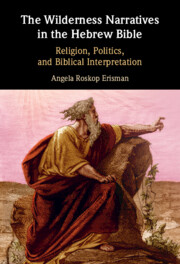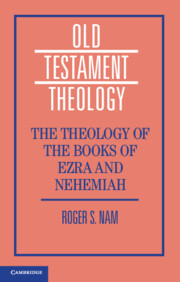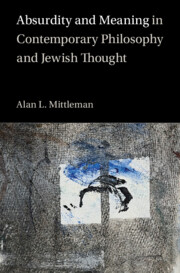Refine search
Actions for selected content:
38 results
Chapter 4 - A Soft Metaphysics for Jewish Theology
- from Part II - Reviving Jewish Theology
-
- Book:
- Reviving Jewish Theology
- Published online:
- 20 November 2025
- Print publication:
- 04 December 2025, pp 79-110
-
- Chapter
- Export citation
6 - Wildfires and Climate Change
- from Part I - Eight Articles from the Bulletin of the Atomic Scientists
-
- Book:
- Climate Change Science
- Published online:
- 13 November 2025
- Print publication:
- 20 November 2025, pp 29-32
-
- Chapter
- Export citation

The Theology of the Letter to the Galatians
-
- Published online:
- 07 August 2025
- Print publication:
- 07 August 2025
7 - Jewish Architecture
- from Part I - Architecture and Iconography
-
- Book:
- The Cambridge Encyclopaedia of Late Antique Art and Archaeology
- Published online:
- 04 July 2025
- Print publication:
- 31 July 2025, pp 108-127
-
- Chapter
- Export citation

Ancient Mythologies of the Wilderness
- Narrative, Nature, and Religious Identity Formation from the Babylonians to the Late Antique Christians
-
- Published online:
- 10 April 2025
- Print publication:
- 17 April 2025

The Wilderness Narratives in the Hebrew Bible
- Religion, Politics, and Biblical Interpretation
-
- Published online:
- 12 December 2024
- Print publication:
- 19 December 2024
1 - Life and Aims of Jesus
- from Part I - Origins
-
-
- Book:
- The New Cambridge Companion to Jesus
- Published online:
- 15 November 2024
- Print publication:
- 05 December 2024, pp 11-25
-
- Chapter
- Export citation
2 - Jesus’s Religion, Praxis, and Experience of God
- from Part I - Origins
-
-
- Book:
- The New Cambridge Companion to Jesus
- Published online:
- 15 November 2024
- Print publication:
- 05 December 2024, pp 26-43
-
- Chapter
- Export citation
3 - Ezra–Nehemiah and the Old Testament
-
- Book:
- The Theology of the Books of Ezra and Nehemiah
- Published online:
- 31 October 2024
- Print publication:
- 21 November 2024, pp 118-170
-
- Chapter
- Export citation
2 - The Theology of the Books of Ezra and Nehemiah
-
- Book:
- The Theology of the Books of Ezra and Nehemiah
- Published online:
- 31 October 2024
- Print publication:
- 21 November 2024, pp 40-117
-
- Chapter
- Export citation

The Theology of the Books of Ezra and Nehemiah
-
- Published online:
- 31 October 2024
- Print publication:
- 21 November 2024

Paul and Judaism at the End of History
-
- Published online:
- 23 October 2024
- Print publication:
- 10 October 2024
The Stomach Purifies All Foods: Jesus’ Anatomical Argument in Mark 7.18–19
-
- Journal:
- New Testament Studies / Volume 70 / Issue 3 / July 2024
- Published online by Cambridge University Press:
- 30 September 2024, pp. 371-391
- Print publication:
- July 2024
-
- Article
-
- You have access
- Open access
- HTML
- Export citation
4 - Salvation through Justification
-
- Book:
- Paul and the Resurrection of Israel
- Published online:
- 02 November 2023
- Print publication:
- 23 November 2023, pp 145-181
-
- Chapter
- Export citation
6 - God’s Justice and the End of the Torah
-
- Book:
- Paul and the Resurrection of Israel
- Published online:
- 02 November 2023
- Print publication:
- 23 November 2023, pp 221-270
-
- Chapter
- Export citation
3 - The Israel Problem and the Gentiles
-
- Book:
- Paul and the Resurrection of Israel
- Published online:
- 02 November 2023
- Print publication:
- 23 November 2023, pp 107-144
-
- Chapter
- Export citation
4 - A Historical Icon
- from Part II - The Incarnation of the Word
-
- Book:
- An Augustinian Christology
- Published online:
- 02 November 2023
- Print publication:
- 16 November 2023, pp 146-173
-
- Chapter
- Export citation
4 - Listening to the Prophet
-
- Book:
- Prophets and Prophecy in the Late Antique Near East
- Published online:
- 26 October 2023
- Print publication:
- 09 November 2023, pp 155-196
-
- Chapter
- Export citation

Paul and the Resurrection of Israel
- Jews, Former Gentiles, Israelites
-
- Published online:
- 02 November 2023
- Print publication:
- 23 November 2023

Absurdity and Meaning in Contemporary Philosophy and Jewish Thought
-
- Published online:
- 19 October 2023
- Print publication:
- 02 November 2023
